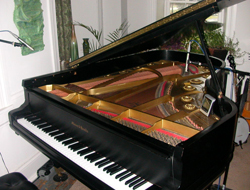
2) The Wide Stereo, Balanced Piano
This technique can provide a warm yet detailed tone, but will always create a wide stereo image. Again using cardioid or omni mics, place one mike over the upper treble section of the instrument and place one mike over the lower bass section of the instrument.
The mic over the high strings will be closer to the keyboard, while the bass mic will be closer to the tail of the instrument. Again, distance can vary from just a few inches to sometimes as much as a foot from the strings.
In this case, the closer the mic, the more detailed the sound, while the further the mic the more accurately you can capture the entire range of the instrument.
3) The Mono, Or Small Stereo, Balanced Piano
Working just inside the crook of the piano, (the place where the curve of the frame makes the piano narrower at the tail than at the keyboard) an XY, M and S, or a simple mono mic can be used to get the most balanced representation of the instrument while maintaining a good sum to mono when necessary.
In this case, you probably won’t want to get too close to the strings so that you can be sure to capture the entire instrument. I suggest using cardioids here to help eliminate unwanted room sound.
Try to aim the mic or array of mics toward the place where the lid connects to the frame while staying at least a good foot or two away from the strings. The sound isn’t quite as detailed, but the stereo choices available during mix make this a good “go-to” technique.
4) The Mellow Piano
The further you move toward the tail of the instrument, the warmer the tone you can capture off the soundboard. Feel free to experiment with distances and miking techniques; there isn’t one I’d necessarily recommend here.
For an extremely warm sound, try miking the underside of the soundboard. You might need at least one mic on the upper side to capture enough detail to make the sound useable.
5) The Most Balanced And Natural Piano
If we move our mic arrays just outside of the frame of the piano, we can still get a close sound and probably the best natural balance of the instrument. For this technique, I like to use an AB pair, spaced only 1 or 2 feet apart, near the crook of the piano but at least two or three feet away from the frame of the instrument. Be sure to get your array high enough that the microphones can “see” all of the strings in the instrument.
As this technique captures the most room, it might not fit a busy rock mix, but instead could be better for solo jazz or similar.
As the mics are moved away from the hammers and toward the tail of the piano, the warmth of tone increases while the percussiveness decreases. Even in this 5th technique, while the crook of the piano might provide the most balanced tone, you may want to move your array toward the keyboard or toward the tail depending on the type of sound you’re going for.
I almost always use omnis to record a piano due to their ability to accurately capture the entire range of the instrument, but don’t be afraid to try and skillfully use the proximity effect of cardioids for some interesting sounds. If you’re recording jazz, microphones like Schoeps, DPA, Earthworks, and Sennheiser MKHs are usually the best. They provide great frequency response and transparency, which is expected in the genre.
With rock and pop material, feel free to use anything you can dream up to achieve the desired sound. Tube mikes, through a tube pre, and to tape can turn a banging pianist into the perfect fit for a track. Yet, transparent can also still be the way to go. Use your ears to help you determine what technique is best.
Internationally awarded and recognized, Charles Szczepanek has enjoyed performing for diverse audiences as well as engineering and producing for many highly-respected artists across multiple genres. Hailed a “whiz” and “genius” by some, he has collaborated with Grammy Award winners. Additional personal achievements include multiple international prizes for piano performance, recognition by Steinway for “Outstanding Piano Performance,” as well as awards in music composition, ensemble direction, and vocal performance.
Be sure to visit the Pro Audio Files for more great recording content. To comment or ask questions about this article go here.
